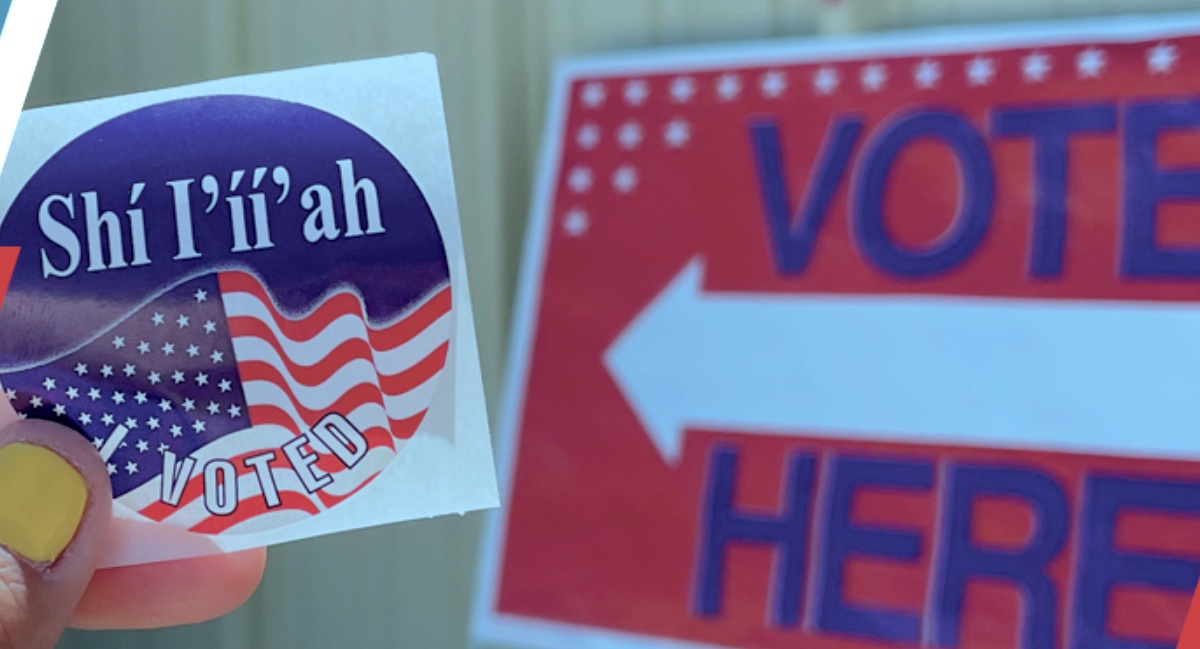
When they Get to Vote, Native Americans Swing Elections By Peter White
Indian lawyers have been winning lawsuits against gerrymandering and restrictive voting laws in Arizona, New Mexico, Montana, North Dakota, and Alaska. Despite more laws making it harder to vote, Native Americans keep on casting ballots.
Native American voters “have the power to swing a host of elections this coming year,” says Jacqueline De Leon, a member of the Isleta Pueblo and staff attorney with the Native American Rights Fund (NARF). Which explains, she adds, “the ongoing hostility towards Native Americans voting and a dramatic rise in laws that are aimed to make it difficult or impossible for Native Americans to vote.”
De Leon was speaking at a news briefing on Indian Country’s fight for fair representation cosponsored by Ethnic Media Services, Indian Country Today (ICT), and First Nations Experience (FNX). ICT Editor-at Large Mark Trahant moderated.
Even though the eligible Native American voting population is small – less than 1% according to Trahant – Native Americans have already swung elections for Senator Lisa Murkowski and Representative Mary Peltola in Alaska, Senator Jon Tester in Montana, and former Senator Heidi Heitkamp in North Dakota. Voting age Indians could swing elections in Wisconsin, Michigan, Minnesota, and Nevada in the coming year.
In 2020 De Leon co-authored a 200-page NARF report called “Obstacles at Every Turn” which explains why Native American voter turnout has historically been so low.
“It details the absurd structural barriers that Native Americans face,” De Leon says.
They include far away polling places, few voter registration opportunities, lack of residence mail delivery that makes registering or receiving a ballot difficult or impossible. Reliable transportation over rough roads to vote in November is always a problem.
“The reason these barriers exist is because of the power and potential of the Native American vote,” De Leon says.
Arizona
Last year Arizona’s Congressional District 2 was redrawn by the legislature, replacing a large number of Hispanic voters near Tucson with voters in Yavapai County which historically has not been friendly to Indian tribes.
“There was no need to do that,” according to Derrick Beetso, director of the Indian Gaming and Self Governance program at Arizona State University’s Sandra Day O’Connor College of Law in Phoenix. There had been no huge influx or exodus of people in these communities. “You’ll see the same grandma living in the same house. All the same tribal members live where they’ve lived and all the different individuals that are impacted in Yavapai county and other counties still live in the same area.
“The only conclusion we are led to believe is that it was done for political purposes rather than to make sure that everyone’s vote counts,” Beetso said.
North Dakota
In 2017 Republicans passed a new voter ID law in North Dakota that disenfranchises Native Americans because they can’t put a residential address on their voter registration application.
Native American voters use post office boxes as an address and there are no post offices on reservations. It’s one of what De Leon calls “absurd structural barriers” that also makes it difficult for Native Americans to vote by mail. The Supreme Court let stand that law and in 2018 Sen. Heidi Heitkamp lost her seat to Republican Kevin Cramer.
“Our biggest challenge is making contact with voters in remote rural communities. Back in 2018 there were a lot of organizations here and we were able to turn out more than 50 percent of the native vote in North Dakota,” says Nicole Donaghy. She is a Hunkpapa Lakota from the Standing Rock Sioux Nation and Executive Director of North Dakota Native Voice.
But since then voting has become more cumbersome. In 2021, 21 bills were proposed to change voting laws. But only two were passed. “We worked alongside NARF and our tribal leaders to play defense against the ever-growing attempts to create these voting laws.”
In 2021 the North Dakota legislature drew election maps but there were no hearings in Indian Country. Donaghy organized people to testify in Bismark, the state capital.
“We were able to create two split house districts in North Dakota which was a huge win.”
Donaghy says there are a record number of Native Americans (10) running for office in 2022. N.D. Native Vote is using a GIS-based digital platform in its Pledge to Vote campaign.
“We can see in real time heat maps of where people are pledging to vote and also help guide us to where we need to focus our canvas.“
There is only one polling place per county and none of the polling places on reservations offer early voting. Donaghy is organizing poll watchers to protect against the kind of voter intimidation that occurred in the 2018 election.
Alaska
The biggest success story in Indian Country redistricting is Alaska.
For the first time in Alaska, two Native Americans served on the 5-member redistricting board. Nicole Borromeo, executive vice president and general counsel for the Alaska Federation of Natives, was one of them.
“It has been the fairest, most transparent process we have ever had in the state,” Borromeo says.
Borromeo, who hails from McGrath in the Alaskan interior, learned the software and mapped 4-10 hours a day for about a month. She drafted 40 house district maps that were paired with 20 senate district maps
Borromeo says it was a very nonpartisan process until one board member tried to gerrymander two senate districts near Anchorage. There was a lawsuit and the case went to the state Supreme Court. It set a legal precedent, holding that gerrymanders violate the state constitution. Another attempt to gerrymander also failed.
There was some backroom dealing until the Supreme Court ordered the board to adopt the maps it approved. It approved Borromeo’s version of the election maps.
